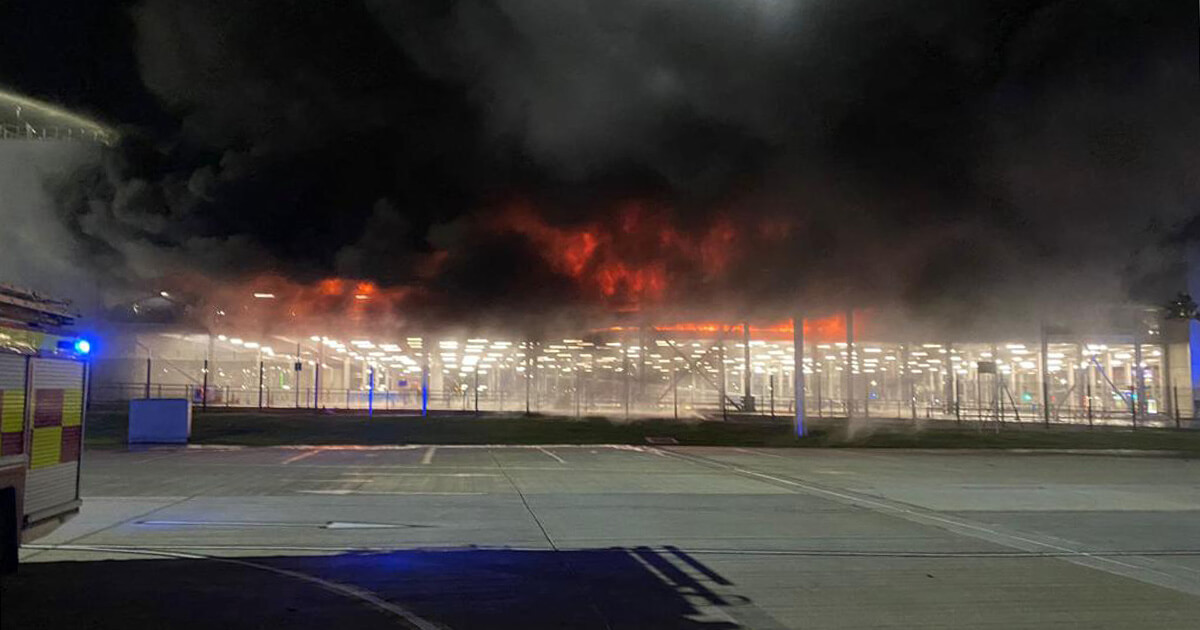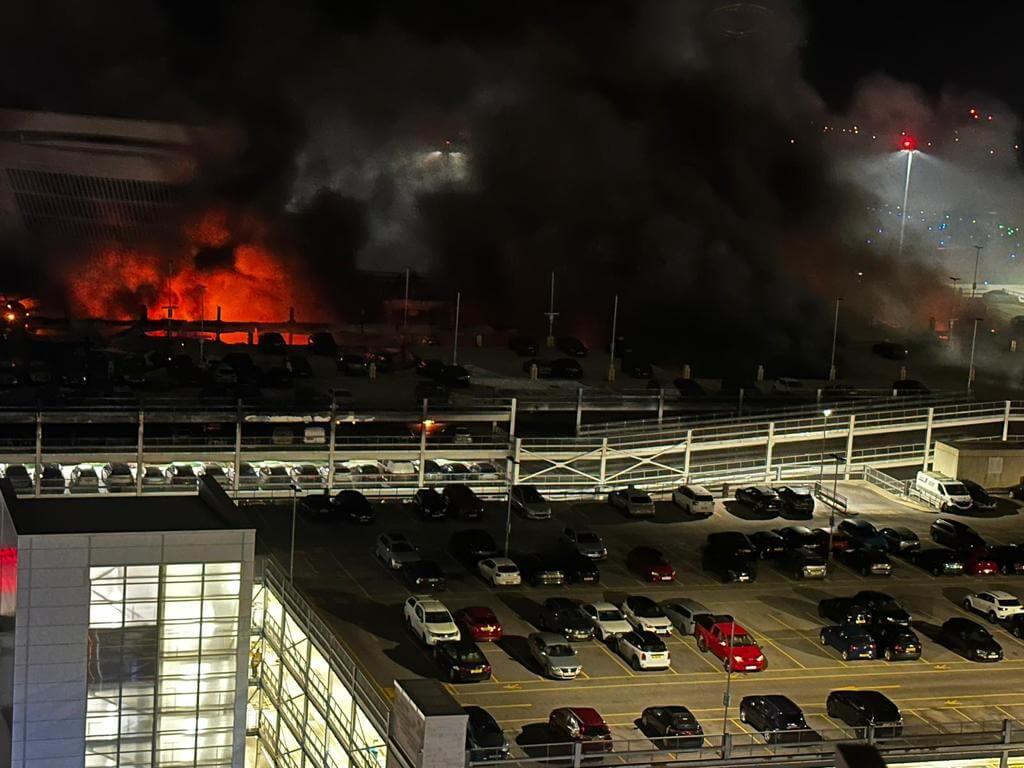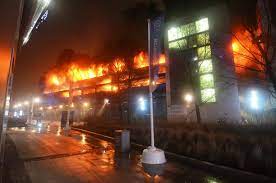
Habitable spaces today are constructed with more synthetic materials than in the past. And into these spaces we cram all manner of battery-powered devices that burn very hot and release toxic smoke.
In part 1 of this series, we wondered if it’s time to debate the adequacy of the cellulosic fire test standards we use to evaluate a material’s thermal response.
And in our view, the answer is yes.
In fact, recent history is rife with near misses and tragic events that, as we argue below, have already settled the debate.
Luton, United Kingdom
An accidental ignition inside a vehicle parked at London Luton Airport Terminal Car Park 2 on Oct. 10, 2023, led to the catastrophic fire during which part of the multi-level structure collapsed.
The incident is recent enough at this writing in February 2024 that formal findings remain pending. But a principal criticism that emerged in the immediate aftermath was that Terminal Car Park 2 had no fire suppression sprinklers.

The frenzied claim on social media that an electric vehicle (EV) was the source of the fire was false.
But even though an EV battery thermal runaway did not cause the event, EVs were parked inside the structure, and some fueled the blaze. Law firm Browne Jacobson noted that it takes more than twice the amount of water to douse an EV battery fire compared to a traditional vehicle fire.
In fact, firefighters ordinarily elect not to fight battery fires at all because it’s safer for everyone. They only initiate a firefight to contain some more catastrophic risk.
EV market penetration will only grow. There will never be fewer of them in parking structures than there are right now.
Fortunately, no one died in the fire, although some firefighters and an airport employee suffered smoke inhalation. But the cost of the Luton disaster will still be mighty, mostly to insurers. The Bedfordshire Fire & Rescue Service Fire said in late 2023 it’s unlikely that any of the 1,405 cars they knew to be in the car park at the time of the fire would be usable after what remains of the car park is demolished.
Stavanger, Norway
Much more is known about the fire, first response, and aftermath of the Jan. 7, 2020 car park fire at Stavanger Airport Parking Building 3.
The fire resulted in a partial collapse of the multi-level parking structure and the destruction of hundreds of vehicles.
A RISE Fire Research report establishes key facts which are crucial to any discussion of modern fire loads and the adequacy of legacy material response test methods.
One is that there were no fire suppression sprinklers, same as Luton.
Another is that the fire originated in a parked car in an upper level, a location which fire service personnel reported was difficult to access with their large apparatus. The report also indicated firefighters initially had difficulty locating fire hydrants, delaying their firefight.
Next, the portion of the parking structure that collapsed was a newer build, utilizing different materials not considered in older fire safety designs which were repurposed for its construction. Newer designs existed but their changes compared to older designs were not adequately emphasized, according to the report.
Also noteworthy is the fire development timeline. For the first 15 or so minutes from ignition, the fire was apparently contained to a single vehicle. But then, witnesses reported hearing a “bang” from an electric vehicle parked near the burning car (the EV, to be clear, was not the cause of the fire). Just a minute after the bang, witnesses observed flames, heard more bangs, and saw several more cars on fire.
After only 18 minutes and 17 seconds, 10 cars were burning. The first fire trucks were not deployed until 19 minutes after ignition. Crews fought the fire for little more than an hour before evacuating ahead of the structure’s imminent collapse.
No fire service response can be instantaneous or perfect. But keep Stavanger in mind as you consider that structural steel loses half its load-bearing integrity once it reaches 1,000°F (538°C), and that an EV battery can reach 1,832°F (1,000°C) in as little as five seconds in a thermal runaway event.
As EVs proliferate, it is urgent that stakeholders scrutinize trends in construction materials, the performance of passive fire protection (PFP) products, and operative thermal response test methods—and to say so frankly if these all fall short against modern fire loads.
Liverpool, United Kingdom
The fire that destroyed the King’s Dock car park in Liverpool on New Year’s Eve 2017 also began in a parked combustion-engine car. The Merseyside Fire & Rescue Service protection report published in the aftermath details the convergence of factors that made this as bad as it was.
For one example, the Service’s evidence strongly refuted a decades-old assertion that fires in multi-story, reinforced concrete parking structures tend not to spread from floor to floor. In the early stage of the King’s Dock fire, intense heat melted plastic and aluminum drainage infrastructure above the burning vehicle which provided a vector for its spread to the floor above.

Another serious hazard was plastic petrol tanks in most of the parked cars. Investigators reported that as tank after tank failed, an intense running fuel fire developed.
Further, there was clear evidence of widespread heat-induced failure of the structure’s concrete floor slabs which aided the spread of the fire from level to level.
It could have been far worse. The King’s Dock car park was adjacent to the Arena Convention Center of Liverpool, where the Liverpool International Horse Show was in progress at the time of the fire. Thousands of spectators were safely evacuated. Also evacuated were the residents of two apartment buildings erected just beside the car park.
Firefighters noted that the location of these residential structures prevented them from deploying aerial firefighting appliances in ideal positions. Fortunately, those apartment buildings and their occupants survived the fire. Minor injuries were reported, most of them smoke inhalation.
Jecheon, South Korea
Bad as they are, the disasters described above do not represent the worst-case scenario.
But the fire that destroyed the multi-story Jecheon Sports Center in the small town of Jecheon, South Korea, does.
Twenty-nine people died and dozens more were injured on Dec. 17, 2017, after a fire that started in the ceiling above a partially enclosed ground-floor parking area spread quickly upward.
According to the investigation following the fire, a faulty electrical wire installed to prevent piping from freezing sparked the blaze which spread rapidly once it encountered insulation in the ceiling of the parking area.
This small town’s firefighters were completely overwhelmed, the most agonizing example being their choice to try preventing the explosion of a nearby propane storage tank instead of entering the building to attempt immediate rescues. They did not have enough people or equipment to do both at once.
That the Jecheon Sports Center did not collapse only demonstrates that a structural failure is not a prerequisite for tragedy. Thick plumes of toxic smoke and an under-equipped, under-staffed fire service were the culprits here.
Coming in part 3: What change looks like
The events narrated above do not constitute anything like an exhaustive list. The more we looked, the more examples we found.
Nor does our selection of the events suggest that EVs are bad or that we should be afraid of parking structures.
But these examples are instructive in demonstrating the many and complex hazards that modern fire loads pose in today’s built environment:
First, EVs and even larger, grid-scale energy storage systems will proliferate. Thermal runaways did not cause these fires, but it is still true that EVs and other energy storage assets release more heat, release it more quickly, and create more toxic byproducts when they burn versus conventional materials.
Second, the construction of mixed-use spaces favoring higher density will continue accelerating. So will the use of synthetic building materials and furnishings, which feature higher calorific potentials than the traditional materials on which today’s thermal response testing methods are based.
Third, parking structures are an exceptionally difficult venue for firefighters because they often impede access and cause decisive action to be delayed. When these structures are incorporated within a mixed-use envelope, the difficulties and risks each compound.
Our objective in part 1 of this series was to suggest that, owing to modern fire loads, the adequacy of cellulosic fire test standards in use today to evaluate materials’ fire resistive properties should be up for debate.
The objective here was to argue that what happened in Luton, Stavanger, Liverpool, and Jecheon demonstrate that this debate is already settled.
In the final installment of this series, we’ll explore the quandary of modern fire loads against obsolete material response evaluation methods from the lens of the myriad stakeholders—insurers, architects, engineers, builders, and others—who will bear the high and growing cost that will accrue until that gap is closed.
And, we’ll suggest alternative material response evaluation methods that might be better suited to a present and future of hotter, more dangerous fires.

